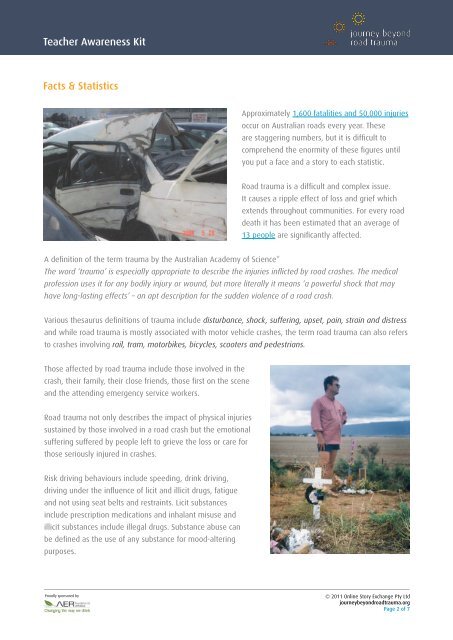Teacher Awareness Kit - Journey Beyond Road Trauma
Teacher Awareness Kit - Journey Beyond Road Trauma
Teacher Awareness Kit - Journey Beyond Road Trauma
Create successful ePaper yourself
Turn your PDF publications into a flip-book with our unique Google optimized e-Paper software.
<strong>Teacher</strong> <strong>Awareness</strong> <strong>Kit</strong><br />
Facts & Statistics<br />
Proudly sponsored by<br />
Approximately 1,600 fatalities and 50,000 injuries<br />
occur on Australian roads every year. These<br />
are staggering numbers, but it is difficult to<br />
comprehend the enormity of these figures until<br />
you put a face and a story to each statistic.<br />
<strong>Road</strong> trauma is a difficult and complex issue.<br />
It causes a ripple effect of loss and grief which<br />
extends throughout communities. For every road<br />
death it has been estimated that an average of<br />
13 people are significantly affected.<br />
A definition of the term trauma by the Australian Academy of Science*<br />
The word ‘trauma’ is especially appropriate to describe the injuries inflicted by road crashes. The medical<br />
profession uses it for any bodily injury or wound, but more literally it means ‘a powerful shock that may<br />
have long-lasting effects’ – an apt description for the sudden violence of a road crash.<br />
Various thesaurus definitions of trauma include disturbance, shock, suffering, upset, pain, strain and distress<br />
and while road trauma is mostly associated with motor vehicle crashes, the term road trauma can also refers<br />
to crashes involving rail, tram, motorbikes, bicycles, scooters and pedestrians.<br />
Those affected by road trauma include those involved in the<br />
crash, their family, their close friends, those first on the scene<br />
and the attending emergency service workers.<br />
<strong>Road</strong> trauma not only describes the impact of physical injuries<br />
sustained by those involved in a road crash but the emotional<br />
suffering suffered by people left to grieve the loss or care for<br />
those seriously injured in crashes.<br />
Risk driving behaviours include speeding, drink driving,<br />
driving under the influence of licit and illicit drugs, fatigue<br />
and not using seat belts and restraints. Licit substances<br />
include prescription medications and inhalant misuse and<br />
illicit substances include illegal drugs. Substance abuse can<br />
be defined as the use of any substance for mood-altering<br />
purposes.<br />
© 2011 Online Story Exchange Pty Ltd<br />
journeybeyondroadtrauma.org<br />
Page 2 of 7


